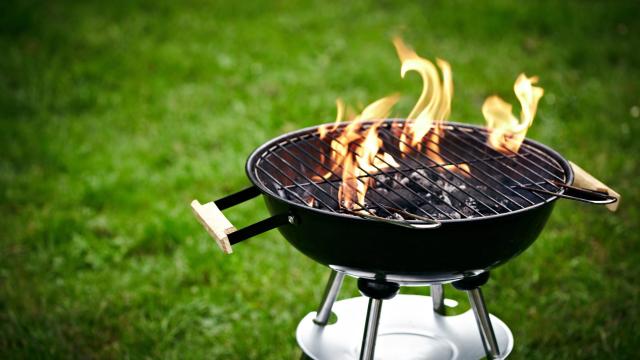Temperature control is one of the hardest things to wrap your head around as a baby charcoal griller. There are no dials to twist, no knobs to adjust, and the only numbers you’ll find are on a probably extremely inaccurate thermometer. (Depending on where you place your thermometer in relationship to the coils, it can be as much as 200 degrees off!)
Controlling the temperature of your charcoal BBQ is all about controlling the air flow. The more air you have moving through your grill, the more oxygen the combustion reaction will see, and the hotter your coals will burn. Opening up the intake vents (located under the coals) and the exhaust vent (above the coals, usually in the lid of your grill) is the easiest way to increase the flow of oxygen, but there are other factors that can keep your grill from getting as hot as you need it to be.
Check the charcoal
Mixing in a little partially-used, leftover charcoal with the fresh stuff is ok if you’re cooking hot dogs or something equally quick and simple, but half-burnt briquettes will only last you half as long, so start with fresh, whole charcoal if you need to do a moderately long or hot cook, and make sure it is dry, and fairly new. (It doesn’t have to be brand new, but charcoal that’s been sitting in the garage since last summer may have absorbed moisture from its environment, causing it to light and burn poorly.)
Start your coals off right
There are three items I think every baby griller should have — an external thermometer, a charcoal chimney, and lighter cubes. Using the last two is the easiest, quickest way to get your coals super hot and ashy without resorting to using lighter fluid. The chimney maximizes the air flow around the coals and the cubes provide the quick-lighting fuel you need to kick things off without leaving behind any ash (as you would if using newspaper or something similar). You can make your own lighter cubes with paraffin wax and an egg carton, or buy 24 of them for five bucks.
But don’t let them get too ashy
Once you see some flames poking out from the top layer of coals in your chimney, you can go ahead and dump them onto your charcoal grate (the grate that holds the coals, located under the grate that you cook your food on). Once the coals are mostly — but not entirely — covered in ash, it’s time to cook your food. If you’re worried you let them get too ashy — completely grey — don’t panic, just add more coals to the pile.
Is ash blocking your air flow?
When I smoked my first pork shoulder, I had issues with the temp suddenly dropping about 60% of the way through the cook. I still had plenty of charcoal and hadn’t touched the top or bottom vents in hours, and was stumped until I realised I hadn’t emptied out any of the ash that had accumulated below the coals since I began cooking. A few quick back-and-forth swipes of the little cleaning blades — the same ones that control the air flow through the bottom vents — and I was back on track. Keep an eye on your ash, is what I’m saying, and empty it as needed when doing a long cook.
Get an external thermometer
As mentioned earlier, an external thermometer is one of the top three must-haves I recommend to my fellow barbecue babies. The little thermometer that sits on top of your lid is just not accurate. It’s often positioned over the coals, resulting in a falsely high reading, but can also be affected by cold outdoor temperatures, resulting in a falsely low reading. You can get a multi-probe thermometer for about $US30 ($38) that will let you monitor the temperature of your food, as well as the ambient temp inside your grill.
Position your food correctly
The most common charcoal setup is the classic 2-zone arrangement, with the coals on one side of your grill, and the other side left empty. The side with the coals is your “direct zone,” where heat radiates off of the coals and onto your food. This is the side where you want to do your searing. The other side is your “indirect” zone, which is basically an oven. The heat comes off the coals and circulates around the inside of the closed grill, exiting through the exhaust vent (which should be set over the empty, indirect side). Attempting to sear over the coal-less side will not work, and roasting or slow-cooking over the direct side will result in scorched, undercooked food, so choose your zones wisely.

Leave a Reply
You must be logged in to post a comment.